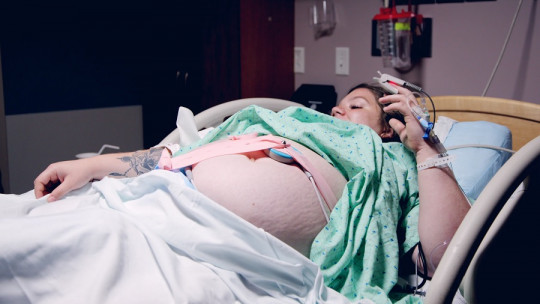Pregnancy, childbirth and the puerperium are processes that, poorly managed, can cause physical and psychological consequences for women, which is why the gynecological and obstetric care received during them must be careful, respectful and focused on their health and that of your child.
Although birth professionals have the knowledge and practice to be able to correctly practice their profession, sometimes Mistakes are made that can harm women’s health and these can lead to what has been called obstetric violence
This term has its history, but it has been going viral in recent days as a result of the new reform of the Abortion Law and the blisters it has caused. Let’s address in depth what this type of violence entails and why it is generating so much debate.
What is obstetric violence?
Obstetric violence is the set of practices and behaviors carried out by professionals in the health field who care for women during pregnancy, childbirth and the postpartum period both in the public and private spheres, which by action or omission involve some degree of violence towards users.
This violence can be physical, in the form of acts that are not appropriate or not consensual by the patient, and psychological, such as treating the user in a paternalistic and humiliating manner.
According to the associations that defend the term, obstetric violence constitutes gender discrimination and involves the violation of human rights from the perspective of women’s health, sexual and reproductive rights The behaviors considered to belong to this type of violence are included in the dehumanized treatment, unjustified medicalization and pathologization of the natural processes associated with childbirth that women can suffer in hospital environments.
The term “obstetric violence” has become a very topical topic. The social debate around this concept and whether or not certain behaviors should be regulated in the clinical care of pregnant women as obstetric violence. It has raised eyebrows both among doctors and in associations in favor of women’s rights and against discrimination
Those who defend the existence of obstetric violence classify it as structural and institutional violence that emanates from a patriarchal culture that affects different areas of society, including medical sciences.
Although it is not a new idea, it has remained hidden and invisible for a long time and, to this day, remains quite unknown, even by health professionals themselves, and is even less known among the users themselves. of gynecology and obstetrics services. Some studies indicate that more than half of health professionals do not have sufficient information about this type of behavior
A problem that is not new, directed towards pregnant women
Although the term has been going viral in recent days, this is nothing new. In fact, the first time the term “obstetric violence” was used appeared in 1827 in an English publication in “The Lancet” as a criticism of the widely spread practices in delivery rooms at the beginning of the 19th century. As the years have gone by, more and more people have become aware of the existence of this type of violence to the point of conducting research on the treatment of pregnant women in health services.
Although with other terms, this phenomenon was already denounced during the 1950s in the United States and the United Kingdom and, in the 1980s, it would be denounced in Brazil from a feminist perspective. Already entering the 20th century, with the emergence of new activist associations such as “Birth is ours” the idea has begun to see light and greater awareness of the problem has begun. Activism against obstetric violence is strongly motivated by the fact that experiencing a traumatic birth is an experience that can cause physical and psychological consequences.
In 2014, the World Health Organization issued a statement warning about the lack of respect that many pregnant women received in health centers, something that was widespread worldwide. Added to this, she insisted on the need to eradicate these behaviors, which are currently considered a serious violation of women’s rights, even when it occurs completely unconsciously or is carried out by a female gynecologist. All of this led, in 2019, to the United Nations (UN) to classify obstetric violence as a widespread phenomenon.
In 2020, the United Nations Committee on the Elimination of Discrimination Against Women (CEDAW) sentenced Spain to compensate a woman who reported having suffered this type of violence. The committee considered as unnecessary procedures the dozen vaginal examinations, induction with oxytocin (hormone to accelerate labor contractions) and episiotomy (incision in the tissue between the anus and vagina) to which the user was subjected without her consent. explicit, typical of a case of obstetric violence.
Women who claim to have been victims of this type of violence feel like some medical professionals do whatever they want with them, as if the body did not belong to them. They denounce that, as soon as they become pregnant, women lose the right over their own body and that the use of any medical practice is justified, no matter how painful and humiliating it may be, using as an argument that anything goes for the simple fact that save the “product”, that is, the fetus. Furthermore, they criticize that almost no one informs them adequately about the procedures and that they become “uteruses with legs.”
Examples of obstetric violence
Activism in favor of the elimination of this type of violence considers that obstetric violence occurs in the form of generalized behaviors in the care of pregnant women as the following:
Some common examples in the care of pregnant women that can be considered obstetric violence are:

- You may be interested: “The 13 types of pain: classification and characteristics”
Why is it given and why is it not known?
Activism against obstetric violence insists that its denunciation should not be seen as a mobilization against the professional practice of health workers, but as an action to raise awareness about widespread malpractice, both accidental and voluntary
This phenomenon is a problem that seems to be quite common, with voices claiming that between 30 and 50% of women in the world have suffered obstetric violence in one way or another, feeling humiliated and humiliated on some occasion when they have visited their gynecologist. or during childbirth.
There are those who consider that the reason why awareness has begun to be raised so recently is because it is a type of symbolic and normalized violence even among pregnant women
There are women who do not dare to report it for fear of being called exaggerated or being told that it is really their hormones who are talking. Added to this, few women are properly informed about their reproductive rights, with many of them believing that it is normal to be subjected to unpleasant medical procedures without giving their explicit consent.
Regarding the health community, one of the reasons that has been used to explain why birth professionals engage in behaviors typical of obstetric violence has to do with burnout syndrome or professional exhaustion. These same professionals may have very high levels of stress and fatigue, so much so that there comes a time when they become frustrated with their work, work more mechanically and dehumanize patients, affecting the doctor-patient relationship.
Another reason that would explain why the health community does not seem to be aware of this problem is that does not receive proper training and information on this type of behavior in addition to not having the necessary tools to detect or manage disrespectful practices towards pregnant women, women in childbirth and in the postpartum period.
Despite there being no intention to commit any harm to the woman, Fatigue motivates wanting to use techniques that speed up delivery and, although safe, they can cause great psychological and physical discomfort to the woman in labor.
- Related article: “Psychology of pregnancy: this is how the pregnant woman’s mind changes”
The debate in Spain
The debate is very active in Spain at the moment, because The Ministry of Equality announced its intention to include obstetric violence as a crime in the reform of the Abortion Law (modification of Organic Law 2/2010), also including it as a subtype of sexist violence. Despite the good intentions behind the measure, it is rejected by gynecologists, both men and women, since it is feared that it will criminalize their profession, in addition to the fact that it could break the doctor-patient relationship and the trust of women. pregnant women in gynecology and obstetrics.
Gynecologists consider that malpractice in childbirth is another form of negligence, which must be duly investigated and penalized if it occurs, as with any bad action by a health worker from any other branch of medical sciences. In this specific case, The gynecological community considers that negligence in childbirth should not be confused with sexist violence as recently expressed by the General Council of Official Medical Associations (CGCOM) or the Professional Union of Free Practice Doctors (Unipromel).
It is worth mentioning that, although critical of the idea of obstetric violence, the Spanish Society of Gynecology and Obstetrics (SEGO) considers it essential listen to women and their partners, facilitate their participation in health policies and demand sufficient resources from the health administration to improve your treatment. In addition, they also value the need to report the deficiencies of the system that, once filled, will facilitate providing respectful maternity care, focused on achieving the healthiest possible birth of the baby and making it a positive experience for the mother.









